
|
Spanish Steps "ROME SEAGULLS"
Panoramic attic - penthouse |
"ROME SEAGULLS": 360 degrees panoramic penthouse, 3 double bedrooms, ample terrace and stunning views of all Rome    - Views from the terrace - Views from the terrace
Most panoramic penthouse, featuring two ample terraces with amazing 360 degree views of all Rome, two bedrooms (matrimonial and twin beds), dining room, two sparkling bathrooms (shower enclosure and Jacuzzi shower), dining room, kitchenette. Elevator. Additional annex with another double bedroom and bathroom possible, for a total occupancy of 4 or 6 persons.
Please click here to INQUIRE
Perfect equipment: air conditioning, independent heating (both high-tech), internet Wi-Fi, fully equipped kitchenette with starter food provided, colour TV set, iron and iron board; hair dryer.
Additional services: parking / Rome expert explaining you all the sights from the terrace with powerful binoculars / Rome guided tours / car service to-from airport or train station / excursions to Pompeii, Tivoli Gardens, Appian Way.
The quintessential Roman panoramic penthouse,
with most hospitable owners. Careful guests please.
|
|
The views from the Rome Seagulls attic are among the most complete of the Eternal City.
You can single out most sights of Rome, within the historical centre, and also beyond. As mentioned the attic is the most advanced observation point of the Spanish Steps district, which is practically perched on a hill.
So unlike other observation points of the Spanish Steps, where from Rome's centre is seen in the distance, the attic projects into Rome's sights.
The photos below show give only some general orientation of the views. For a complete view of what you will actually see with your natural sight, please visit the page about the panoramic views of the attic.
From the terrace of the penthouse you can nearly touch the Steps! |
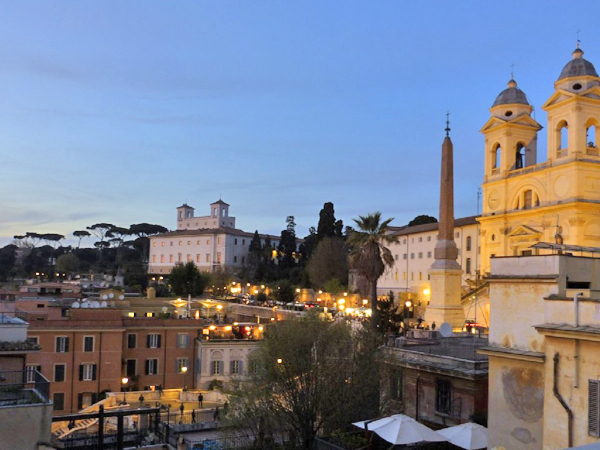 |
The photo above shows the Spanish Steps (you can single out people climbing the steps, and walking in one of its terraces), leading to the famous obelisk at their top, situated in turn in Piazza Trinita' dei Monti, so called because there is a French convent of nuns.
Close-up from the terrace of the Spanish Steps and of Piazza Trinita' dei Monti in a rare snowfall, which occurs in Rome every 10-15 years on average (just for a few days, unfortunately), usually in February.
The Steps, and all Rome, become romantic and fun! You find kids playing with snow balls, and adults who love walking around! |
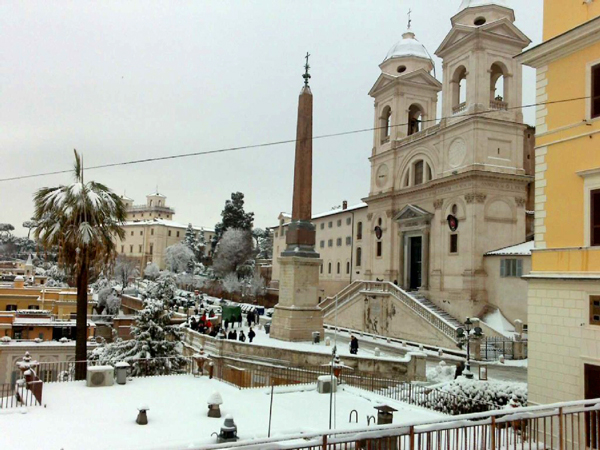 |
The following view is towards West.
The column of Piazza Mignanelli with St. Mary and the tribute of flowers which every Pope leaves every year on Dec. 8, seen from the higher terrace of the attic.
You can also single out three important sights of Rome.
The dome in the forefront is of the Church Sant'Ambrogio e San Carlo al Corso (simply known as San Carlo al Corso), is dedicated to the two saints St. Ambrose and St. Charles Borromeo, both of Milan..
In the distance you can see first the imposing Palazzo di Giustizia (Rome's Superior Tribunal), nicknamed by Romans "Palazzaccio" (Ugly palace) because it is imposing but without the typical Italian charm.
|
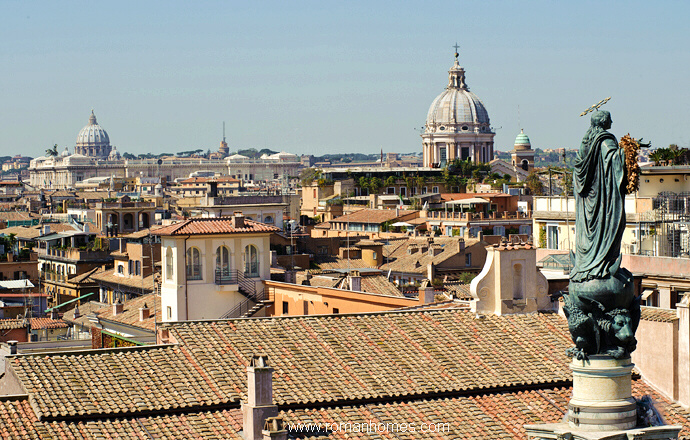 |
Finally you can see St. Peter's dome by Michelangelo, and the Vatican area. You can also single out the broadcasting aerial of the Vatican Radio.
View of Villa Medici and the obelisk and convent of the French nuns in Piazza Trinita' dei Monti |
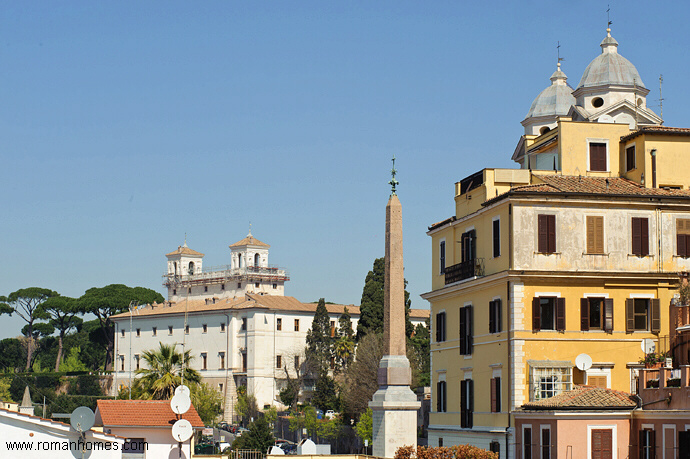 |
Right photo: the Borghese Gardens. To the right you see some palaces which are part of the Villa Medici, or French Academy of Fine Arts, and then the Casina Valadier, built at the beginning of the 19th century by the Roman architect Giuseppe Valadier, and which includes a very sophisticated restaurant with panoramic views of all Rome |
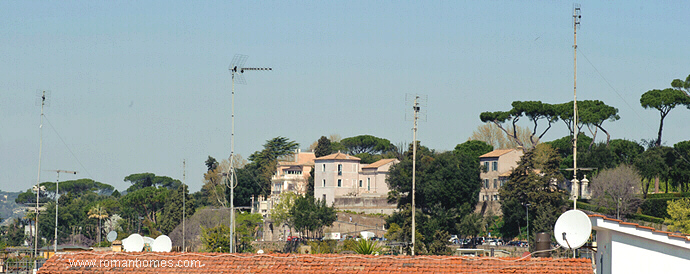 |
The gothic-wise dome is of the All Saints Church (Anglican All Saints). The domes in the background are those of the "twin" churches in Piazza del Popolo Santa Maria in Montesanto (built 1662-75) and Santa Maria dei Miracoli (built 1675-79); finally the belfry of the church Santa Maria del Popolo, built on the burial site of the Roman emperor Nero, and comprising beautiful Caravaggio paintings, namely the famous Crucifixion of St. Peter. In the distance you can see the hill of Monte Mario. |
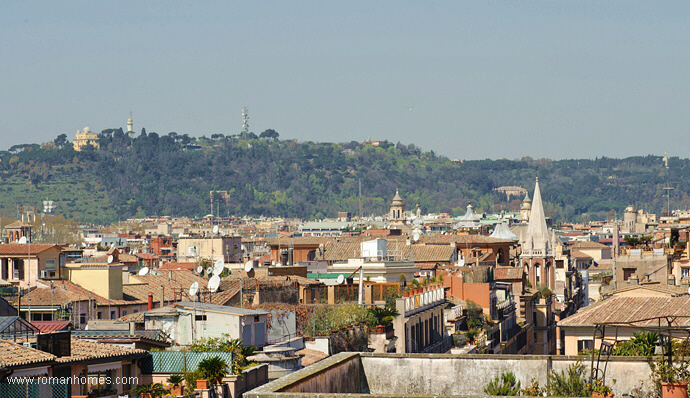 |
The following photo shows another north-ward view.
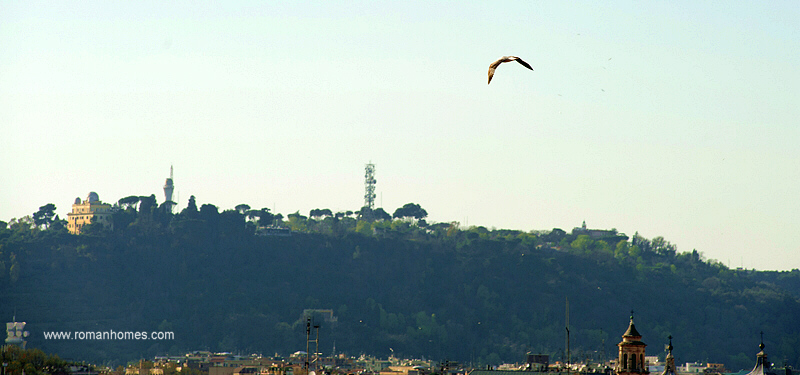 |
Sunset: the Monte Mario hill seen from the terrace, amidst seagulls flying. From left to right you can see; the Astronomical Observatory, followed by another high observation point, then by the terrace of the bar / restaurant "Lo Zodiaco" (very trendy for its panoramic views). It is followed by another gigantic aerial, this time of the Italian State TV. Further to the right you can see one of Rome's most important clinics, Villa Stuart, where the best football (soccer) players are operated and rehabilitated. |
Another northern view.
The Church of San Giacomo and the nearby hospital dedicated to the Saint. It has uniquely two belfries, placed in the back of the church, and not in the front. You can also see in the distance to the left the hotel Cavalieri Hilton, and to the right the Monte Mario Hill and the astronomical observatory. |
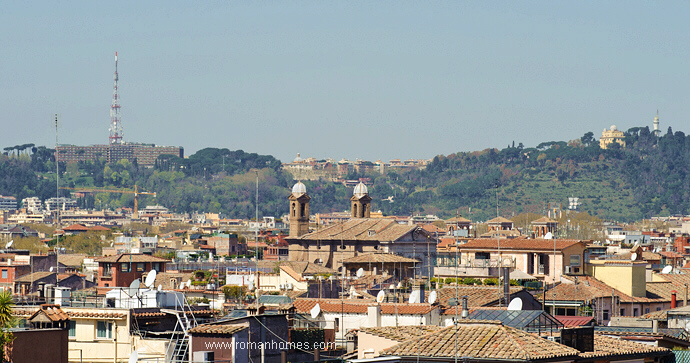 |
The right photo shows a North-West view.
The domes of the churches of San Salvatore in Lauro (left) and of San Giovanni Battista dei Fiorentini (right), which are situated between Piazza Navona and the Tiber. In the background you can see the Pontiff University. |
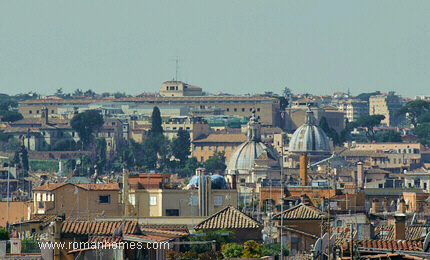 |
Now let's give a look towards West.
 |
Towering over the intriguing jungle of Roman roofs, you can see firstly the Janiculum Hill, Rome's highest hill (though never considered among the seven hills!). In particular you can clearly single out the "Passeggiata del Gianicolo" (Janiculum Walk), where from you have a wonderful panoramic view of Rome, and in particular the Manfredi Lighthouse (Faro di Manfredi), donated by the Italians of South America in 1911 to symbolize the fraternity among Italians. You can walk to the base of the lighthouse, where from you have the widest view of Rome.
Below the lighthouse you can single out the dome and the back of the facade of the Church Chiesa Nuova also knows as Santa Maria in Valicella. Notice the seagull flying to the right of the TV aerial in the forefront. |
Another view towards West.
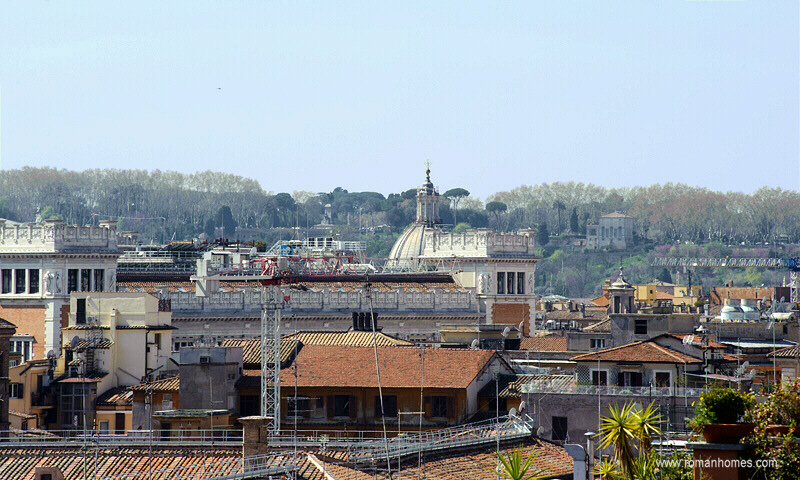 |
In the distance you can see the the Janiculum, the above mentioned Passeggiata del Gianicolo (Janiculum Walk), and the equestrian statue of Giuseppe Garibaldi, overlooking all Rome. He was the national heroe who defended the Roman Republic in 1848 from the invasion of the French Army, and later conquered half of Italy from the Bourbon Court of Naples. Continuing along the Janiculum Walk you find the Palladium-style Villa Lante, nowadays the Finnish Institute of Archeology, where from you have the most stunning view of all Rome, not as complete as from the Manfredi Lighthouse, but clearer and closer to all Rome's sights. The dome in the centre of the photo is of the Church of Sant'Agnese (St. Agnes) in Piazza Navona, by Francesco Borromini. The palace in the forefront is Palazzo Montecitorio, seat of the Italian Parliament. |
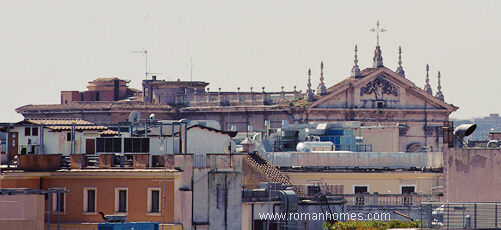
|
South-West view, detail.
The Church of St. Ignazio di Loyola
|
Right, South view, detail: from right to left: the dome of the Chiesa del Gesu' (Jesus Church), the main church of the Jesuit Order, near Piazza Venezia. To the left, in the distance, you see the dome of the Church Santi Pietro e Paolo at the EUR, the peripheral quarter where the Universal Expo of 1942 should have occurred (nowadays it is an elegant quarter with official buildings). To its right, still in the distance, under the flying seagull, you can see two skyscrapers which are being built at the EUR. |
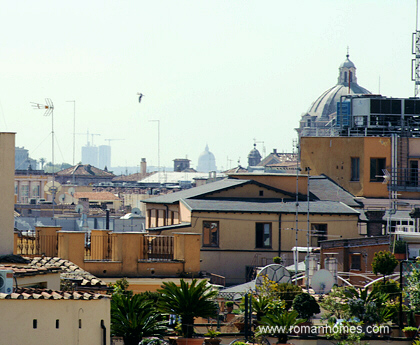 |
The photo below shows a South-West view.
 |
From right to left you can see: the dome of the Pantheon, the world most ancient monument to keep the same function (and to this day still the largest dome of Rome, 43.3 meters, larger than St. Peter's!). Immediately at its back you can see the dome of the Church of Sant'Andrea della Valle, the main church of the order of the Teatini priests. It is the second highest dome of Rome after St. Peter's. Immediately to its left you can single out the dome of the Church Santissima Trinita' dei Pellegrini (Holiest Trinity of Pilgrims), in the Campo de' Fiori district.
After you can single out the pinnacle of the Column of Marcus Aurelius in Piazza Colonna. It is dedicated to the victory of the emperor against three Germanic populations: the Marcomanni, the Sarmatians, and the Quadi, in the II century AD. The column is nearly 40 meters high, although 3 meters were placed below ground level during the restoration of 1589 AD, in which also St. Paul's statue was placed on it (coupling the one of St. Peter's on Trajan's Column, please see below).
To the left you see the dome of the Church of San Carlo ai Catinari, near to the Jewish quarter, still dedicated as the San Carlo al Corso church above mentioned, to the milanese Cardinal Carlo Borromeo. Finally in the background you see the lush Janiculum Hill.
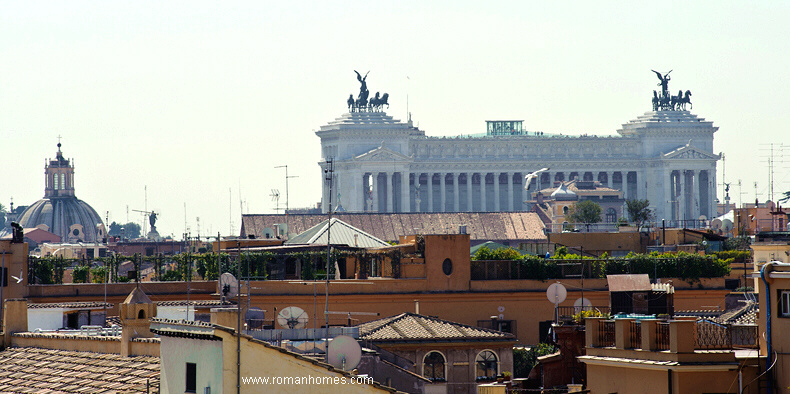 |
The Victor Emmanuel monument (Vittoriale or Altare della Patria in Italian) celebrates the reunion of Italy in 1861, heralded by king Victor Emmanuel II of Savoy. The monument was ended in 1911, and it hosts the unknown soldier of WW1 (thus the name Altar of the Fatherland). The Romans always debated about this monument, as to build it old churches and ancient Roman ruins of Capitol Hill had to be dismantled. For its particular shape, it is also dubbed by Romans the "type writing machine", while the American soldiers during WW2 nicknamed it "the wedding cake".
Just after it, to the left, you can single out the pinnacle of the Trajan Columnn, built to celebrate the victory of Emperor Trajan in his war against former Dacia in 111 AD, for which later it became Romania. The statue on the column is of St. Peter's, and it was placed in 1589 AD.
Finally to the extreme left you can see the dome of the Church Santissimo Nome di Maria, built in the site of the most important library of ancient Rome, and which was part of Trajan's Imperial Forum. |
South-East view, detail:
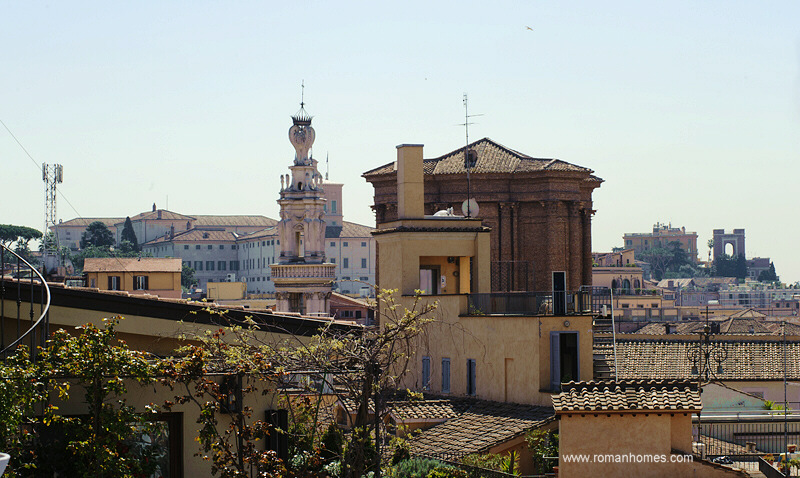 |
The Quirinale Palace and the dome and belfry of the Church Sant'Andrea delle Fratte |
The Church Sant'Andrea delle Fratte was built in the 12th century. Dedicated to the apostle St. Andrew, it was called "delle Fratte" (overgrown vegetation) because it was at that time at the edge of the town. Francesco Borromini, Rome's most genial architect, worked on it between 1653 and 1665. In particular he designed the wonderful belfry.
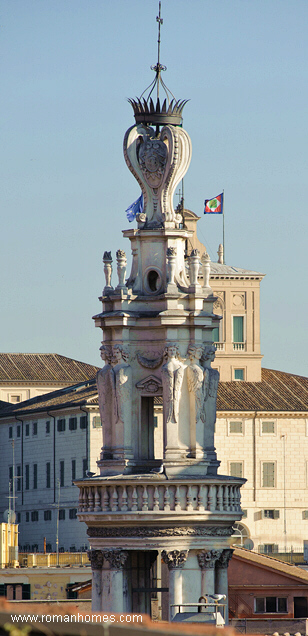 |
The amazing belfry of the Church Sant'Andrea delle Fratte, designed and built by Francesco Borromini. The architect priviliged curved shapes over linear ones, designed with the most imaginative and genial fashion.
The contrast between the extremely sophisticated marble belfry and the rest of the church, built with brown bricks, is astonishing.
The seagulls like the belfry, which they made their home and an observation point.
Behind the belfry you can see the Palazzo Quirinale, one of the greatest palaces in Europe. Built from 1583 AD as a summer residence for the Pope Gregory XIII (Monarch of the Pontifical State), when the Italian army conquered Rome, which thus became capital of Italy in 1871 AD, the palace became the oficial Roman residence of the Kings of Italy (of the Savoy dinasty of Piedmont, in Northern Italy).
At the end of WW2 there was a referundum whose result favouring the creation of a Republic was challenged. The King of Italy and his family were exiled, and the Quirinale became the official residence of the Italian President of the Republic (currently he is Giorgio Napolitano).
The palace has 1,200 rooms, at least 20 very large halls, amazingly lavishly decorated and furnished (precious marble floors, stuccos and frescos of highest quality, Persian carpets up to 200 square meters, Venetian crystal chandeliers nearly 5 meters high etc.), and it is also endowed with large courts and 4 hectares of gardens, in the very heart of Rome's historical centre.
A dedicated regiment of soldiers in high uniform, and also very tall, the "Corazzieri", sees to the security and to all the celebrations taking place in the Palace. |
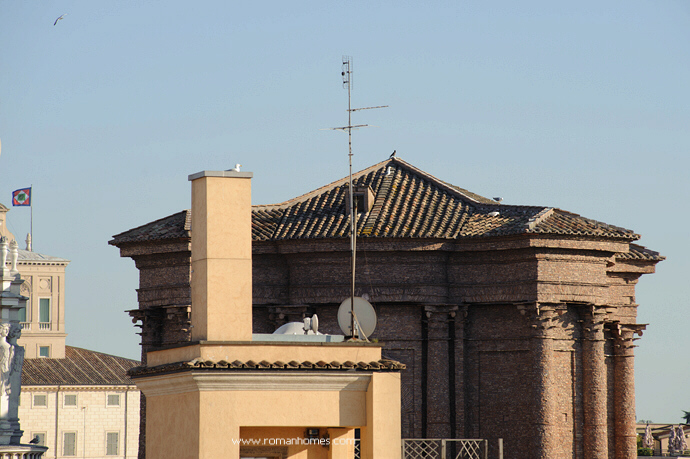 |
The dome of the Church Sant'Andrea delle Fratte, and its seagulls. |
The Church Sant'Andrea delle Fratte pertains to the Order of the Minims. For a short period, before the renovation of Francesco Borromini, it was the national church of the Scottish. The church has also a beautiful cloister with organge trees and cypresses.
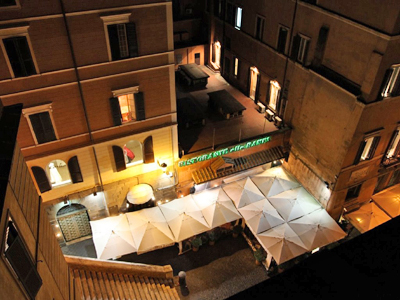
The photo is taken looking downwards, and shows the Mignanelli Climb (steps joining at the end the Spanish Steps) and the restaurant "La Rampa", which guests report as being excellent also price-wise. |
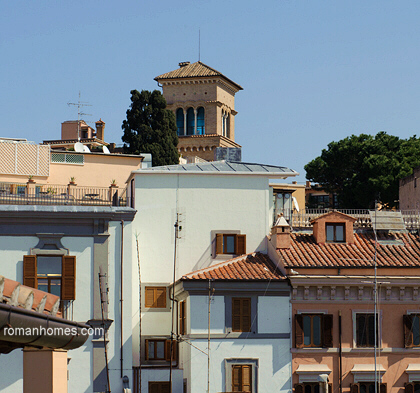 |
The above photos are towards East, and thus towards the Borghese Gardens.
|
The mannerly and aristocratic palaces of Via Gregoriana, Via Sistina and Via Francesco Crispi in the Spanish Steps district. |
i  
|





















